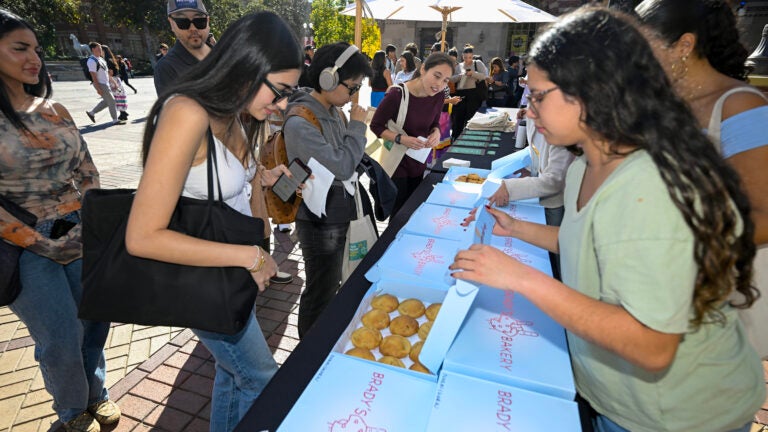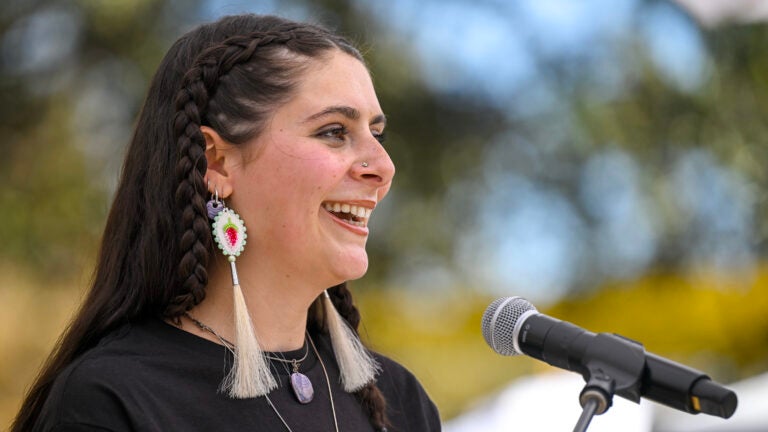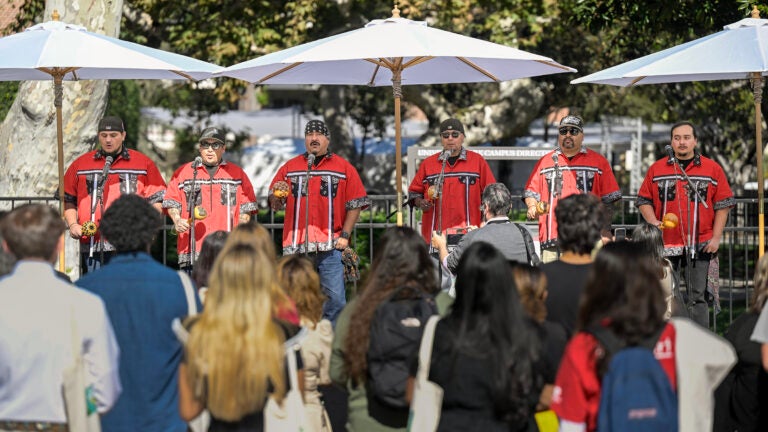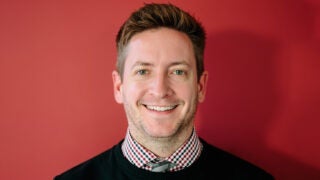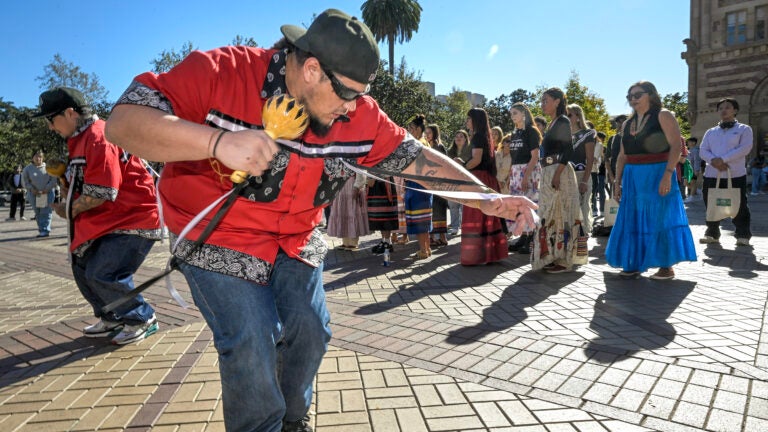
Members of the Torres Martinez Bird Singers dance during the Native American Heritage Month celebration. (USC Photo/Gus Ruelas)
Indigenous Trojans celebrate their history through song, dance and words
More than 200 people attend USC’s campuswide celebration of Native American Heritage Month.
As the Torres Martinez Bird Singers performed a series of songs in Hahn Plaza on Wednesday, graduate student Jeremiah Choate of the USC Dornsife College of Letters, Arts and Sciences wasn’t just watching — he was learning.
Affiliated with the Navajo tribe, Choate was among the more than 200 people to attend a Native American Heritage Month celebration held at USC’s University Park Campus. The event included powerful remarks from students, faculty and staff and performances of a traditional form of Cahuilla music known as bird songs and their accompanying dances.
“I don’t know a lot about the Southern California tribes, so it’s really great to see their song and dance,” Choate said toward the end of the one-hour event.
Derek Duro, head singer of the Torres Martinez Bird Singers, explained to the crowd that bird songs serve as an oral tradition to keep the history and spirit of both a family and a tribe alive.
“The songs aren’t just regular songs; they’re the history of our people and have a lot of meaning and heart in them,” Duro said. “There was no written language. Everything that we did was in song, and all the people knew what the songs represented. The few lyrics had a lot of history behind them.”
Learning about rich histories
One of the featured speakers, USC Rossier School of Education doctoral student and USC Price School of Public Policy staff member Caroline Bhalla, said she has been working on behalf of the Native American community in several ways, including serving as a member of the Los Angeles City/County Native American Commission.
Story continues below photo gallery
“Native American Heritage Month is not only about reflection, but also action,” said Bhalla, a member of the Menominee Indian Tribe. “It offers us all a chance to listen, to learn and to support Native American communities in our ongoing fight for justice, self-determination and cultural preservation.”
Bhalla encouraged the audience to “take this time to educate yourself about the rich histories, cultures and current challenges and opportunities faced by Native peoples.”
Another speaker, Associate Professor Claradina Soto of the Keck School of Medicine of USC, talked about the challenges of “growing up in a world where often our histories are diminished or just left out.”
“This is a time to stand as a reminder of our strength and our beauty and our resilience, and to continue with our narratives,” said Soto, who is from the Navajo and the Pueblo of Jemez tribes. “This month means coming together, honoring our ways and our land, and continuing to move forward in strength.”
During her remarks to the crowd, USC Dornsife senior Cat Broderick reflected on the growth of the Native American community at USC. She noted university achievements including the establishment of the Native American and Pasifika Lounge on campus and the renaming of one of USC’s most iconic academic buildings after Joseph Medicine Crow — a member of the Crow Nation, World War II hero, historian and alumnus who also received an honorary doctorate in 2004 from USC.
“When I reflect on what I am most grateful for, I think of all the laughter, support and love we have grown between us,” said Broderick, who is from the Seneca-Cayuga tribe. “I’m especially grateful to be a part of a community that knows that gathering, art and song are essential to our survival.”
‘It’s always a good day to be Indigenous’
USC Dornsife sophomore Dineh Barragan presented the event’s land acknowledgment — a formal statement that a public event is taking place on land originally inhabited by Indigenous peoples.
She told the crowd that her Gabrielino community ancestors are the original caretakers and stewards of the land where USC’s University Park Campus is located. Barragan is the first in her family to achieve higher education and currently the first and only member of her tribal nation at USC.
“We must recognize, respect and fully support current efforts by all Gabrielino peoples to encourage revitalizing and practicing their traditions and culture,” Barragan said. “Ultimately, we seek to deepen our engagement with the Gabrielino community and its history.”
USC Assistant Director of Undergraduate Admissions Dylan Goodwill also spoke to attendees. Goodwill specializes in Native recruitment and is the advisor to the Native American Student Assembly, which hosted the event presented by the USC Office of Inclusion and Diversity.
“We are very proud of how strong and resilient we are, that we have come from such amazing ancestors who fought for our rights to be here today too,” Goodwill said. “We’re very, very proud each and every day, and like we always say, ‘It’s always a good day to be Indigenous.’”
Students feel connection
Senior Kaitlin Becenti of the USC Annenberg School for Communication and Journalism, a member of the Navajo tribe, said she has been involved with the USC Native American Student Assembly (NASA) since its official recognition in 2021.
“It’s been really amazing to witness the growth of this Native American organization,” Becenti said in an interview before the event. “We’ve been able to supply community for other students and help to make them feel welcome and at home — especially if they come from reservations hundreds of miles away.”
Fellow USC Annenberg senior Ethan Galbraith said in a pre-event interview that due to his geographical distance from his Cayuga tribe in Mississauga, Canada, he had been unable to connect to his Indigenous roots for much of his life.
“Coming to USC and being a part of NASA has given me that opportunity,” Galbraith said. “Whether it’s through different cultural events, sharing stories or just having someone to chat with, we have a connection.”

